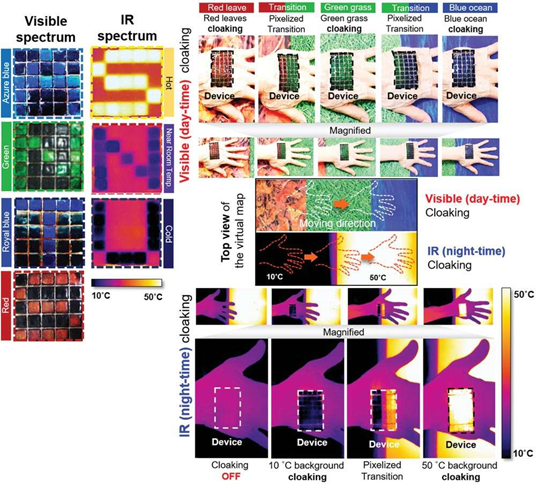
The invisibility cloaks have always been the object of dreams among both Harry Potter fans and various military services. Currently, the world has been presented with several developments that come close to allowing the user to disappear from sight, however, the principles thanks to which they can declare their invisibility are not perfect and require a number of improvements.
We bet that a group of researchers from Seoul National University and Hanyang University will surprise you with their new development: artificial skin that can make a person invisible in both normal light and infrared spectrum. Scientists admitted that they were inspired by cephalopods - octopuses and squids, and by analogy with their biological properties that allow them to hide against any background, they created an elastic device that mimics skin and can quickly change its color depending on the external temperature. The fact that the development allows you to hide not only from the naked eye, but also from devices that see in the infrared spectrum is really impressive! Moreover, the creators promise that you can switch quickly, depending on the situation. The authors hopethat their invention will serve as a prototype for the development of elastic suits that will be of significant use in the covert operations of national troops in the future.
,
Scientists talk about their "mantle" as a more advanced version of the thermochromic material - the one that is widely used in our everyday life - there was a time when mugs were very popular, which changed color depending on the temperature of the drink. It is known that when using certain types of thermochromic substances, the color can change not one, but several, depending on the degree of heating. When mixing red, green and blue, by changing the intensity of one of them, you can achieve millions of different combinations of shades. In theory, a material composed of these three colors would work like a TV, with RGB pixels. However, there is one fatal problem due to which it is simply impossible to create an invisibility cloak from existing thermochromic materials:their color transformation is extremely slow.

Scheme (a) shows a source of biological inspiration - the camouflage of cephalopods in both the visible and infrared ranges. Diagram (b) shows the principle of operation of the new device at the pixel level.
And it was precisely this fatal problem that our South Korean scientists provided a solution to. How? - by means of electric current! After creating a multilayer material with electrodes and a conductive layer, the researchers saw a much faster reaction in color change.

- there is a bifunctional control unit in each pixel of the device, which provides active cooling and heating by using an electric effect
- temperature changes affect the thermochromic layer, causing it to reproduce the desired color
- , , , ,
- -,
- , ,
In order for the suit to "work", only one input variable is needed - temperature! It turns out a completely new type of cloaking system. One device, multispectral - freely and quickly adapts both to the standard range for the human eye and infrared light, carrying out thermal and chromatic control using temperature. This study serves as a proof of concept and still needs significant development for practical application in real conditions. Despite this, it represents a significant leap forward in wearable invisible materials.
Used Books:
- Lee J. et al. Thermally Controlled, Active Imperceptible Artificial Skin in Visible-to-Infrared Range // Advanced Functional Materials. 2020.Vol. 30.No. 36. S. 2003328.
- Scientists Create Artificial Skin That Could Render Wearers Almost Invisible [Electronic resource]. URL: www.iflscience.com/technology/scientists-create-artificial-skin-that-could-render-wearers-almost-invisible